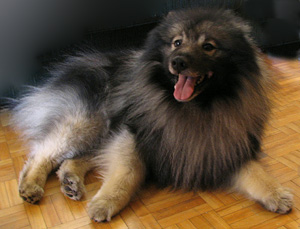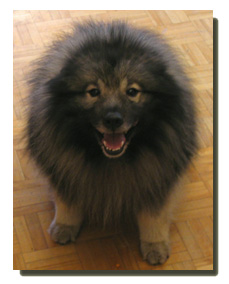
Keeshond
Group: Non-Sporting Group
Origin: Germany
Height: 17 to 18 inches (43-46 cm)
Weight: 30 to 50 lbs.

Calvin
CLICK HERE to View Breeder Listings
Breed Profile
The Keeshond (pronounced “Kaze-hawnd”) is a member of the Spitz family originating in Germany where he is known as the “Wolfspitz.” In Holland, he is known as the “Dutch Barge Dog,” in France as the “Chien Loup” and in Italy as “Lupini.” This is a very old breed, who throughout history, has always been a companion dog. This has resulted in a breed with a wonderful temperament. One who is gentle, devoted, loving and intelligent. Known as the “smiling Dutchman” because of the toothy grin that he sometimes displays, the Keeshond is loyal, protective and excellent with children. He is good-natured, affectionate, full of fun and always eager to please. The Keeshond makes an ideal companion for people of all ages.
He has a foxy expression, prick ears, double coat and carries his tail over his back as do most of the Spitz breeds. His coat has an abundance of long, straight, harsh hair that stands out from the downy undercoat. The coat is very thick around the neck, shoulders and chest, giving the appearance of a lion-like mane. The hair on his head is smooth, soft, short and velvety. He also has the distinct appearance of wearing glasses due to the markings around his eyes that enhance his expression. Another distinct feature is the longer coated pants, which are lighter in colour. In North America, the most common colours are a mixture of black, cream and grey. In other parts of the world, the Keeshond is also seen in black, brown, orange, buff and white.
Health Issues
Like all breeds of dogs, the Keeshond is susceptible to some health problems, including:
- Distichiasis — This is a hereditary disease where there are double rows of eye lashes, one normal and one that turns inward. This can cause eye lashes to rub against the eye thus causing tearing and staining under the eyes. Blindness may result if the extra eyelashes are not surgically removed.
- Epilepsy
- Hypothyroidism — This is a common health problem in several breeds and is the result of a under active thyroid gland.
- Luxating Patellas
- Hip Dysplasia
- Hyperparathyroidism (HPT) — Can cause loose teeth, brittle bones, and kidney damage.
- Allergies
- Cancer
- Heart Disorders
If you are considering the adoption of a Keeshond, or any breed, it is very important to be selective in choosing a responsible and reputable breeder. Ensure that the prospective puppy’s parents have all health clearances. Breeding of any dog should not be done until after they have been proven to be free of evidence of significant hereditary diseases. (For more information on selecting a breeder, see the articles on the main General Information page.)
Additional Health Resources:
- That “P” Word… — Article on HPT from the Keeshond Club of Southern California
- Health and Nutrition — Growing section of the Canada’s Guide to Dogs website which includes information on several health and nutrition related issues.
- Canine Health Information Center (CHIC) — Providing a source of health information for owners, breeders, and scientists that will assist in breeding healthy dogs. CHIC is a centralized canine health database jointly sponsored by the AKC/Canine Health Foundation (AKC/CHF) and the Orthopedic Foundation for Animals (OFA).
- AKC Canine Health Foundation — Working towards developing scientific advances in canine health.
- OFA – Companion Animal Eye Registry (CAER)
- Orthopedic Foundation for Animals (OFA)
- Ontario Veterinary College (OVC)
- University of Pennsylvania Hip Improvement Program (PennHip)
- HealthGene — HealthGene Corporation is the leading provider of veterinary DNA diagnostic services in Canada.
- Labgenvet — Laboratory of Veterinary Genetics is a Canadian diagnostic laboratory that offers a comprehensive service of DNA tests for veterinary genetic diseases.

Calvin
Grooming Information
The Keeshond requires regular grooming to maintain a healthy and mat free coat. Except during seasonal shedding, generally about one hour per week of brushing is needed. During shedding periods, however, grooming time increases to about three to four hours per week.
- Brushing your Keeshond From the Keeshond Club of Southern California
- Grooming — This section of the Canada’s Guide to Dogs website includes tips, articles and information covering all aspects of dog grooming along with a listing of Groomers from across Canada.
Training Resources
The Keeshond is very intelligent, eager to please and easy to train. Training should always be done in a fun and positive manner.
- Training — For training information, see this growing section of the Canada’s Guide to Dogs website for tips, articles, as well as listings of training centres across Canada.
Additional Information
- Clubs, Sports & Activities — For information on the many sports and activities you can get involved in with your dog.
- Working Dogs — The Working Dogs section of the Canada’s Guide to Dogs website provides information and listings of organizations that are involved in various dog jobs, such as Guide Dogs, Therapy Dogs, Police Dogs, Protection Dogs, and much more.
*NOTE 1: CHIC – The Canine Health Information Center “is a database of consolidated health screening results from multiple sources. Co-sponsored by the Orthopedic Foundation for Animals (OFA) and the American Kennel Club (AKC) Canine Health Foundation, CHIC works with parent clubs to identify health screening protocols appropriate for individual breeds. Dogs tested in accordance with the parent club established requirements, that have their results registered and made available in the public domain are issued CHIC numbers.” To learn more, visit: www.caninehealthinfo.org
*NOTE 2: The Fédération Cynologique International (FCI) is the World Canine Organization, which includes 91 members and contract partners (one member per country) that each issue their own pedigrees and train their own judges. The FCI recognizes 344 breeds, with each being the “property” of a specific country. The “owner” countries write the standards of these breeds in co-operation with the Standards and Scientific Commissions of the FCI, and the translation and updating are carried out by the FCI. The FCI is not a breed registry nor does it issue pedigrees.
Breed Listing
Quick Links
Get In Touch
- Email: canadasguidetodogs@gmail.com
- Email: info@canadasguidetodogs.com
- Visit us on Facebook: www.facebook.com/CanadasGuideToDogs
— CanadasGuideToDogs.com is an Amazon Associate as well as a participant in various affiliate programs, as such fees are earned from qualifying purchases.

